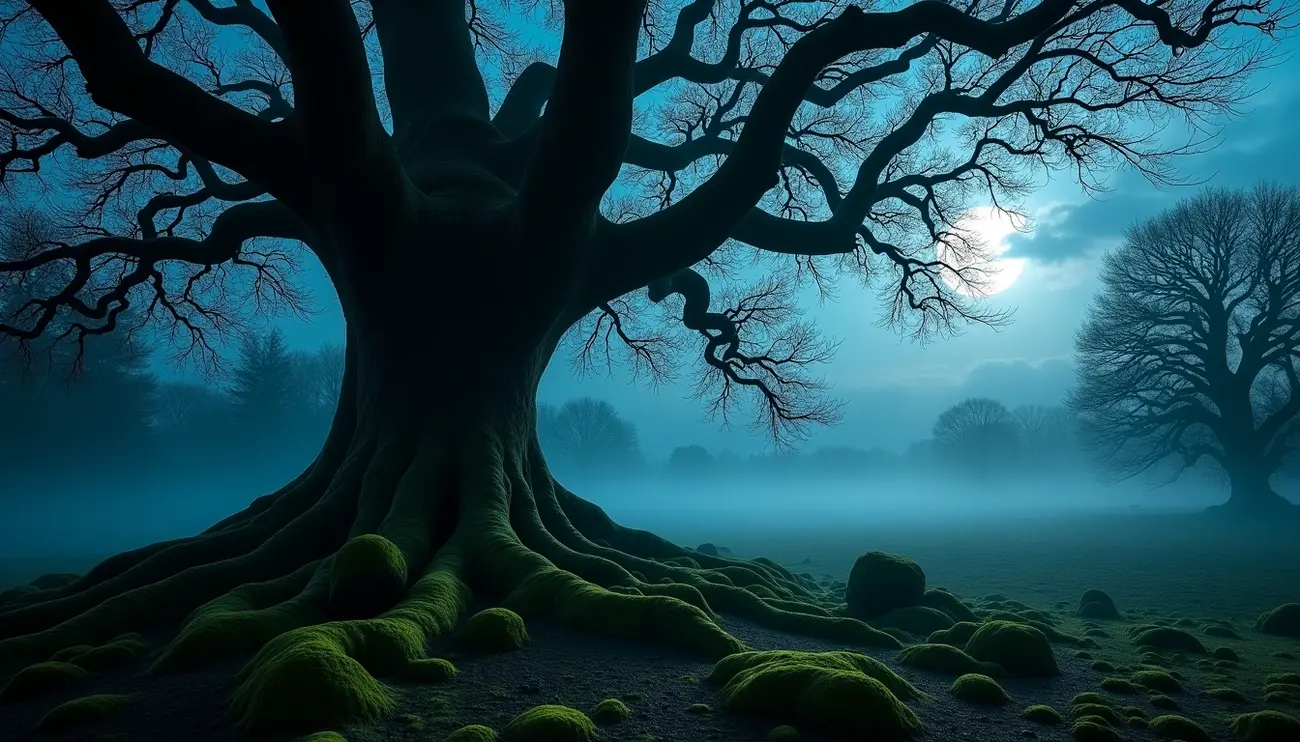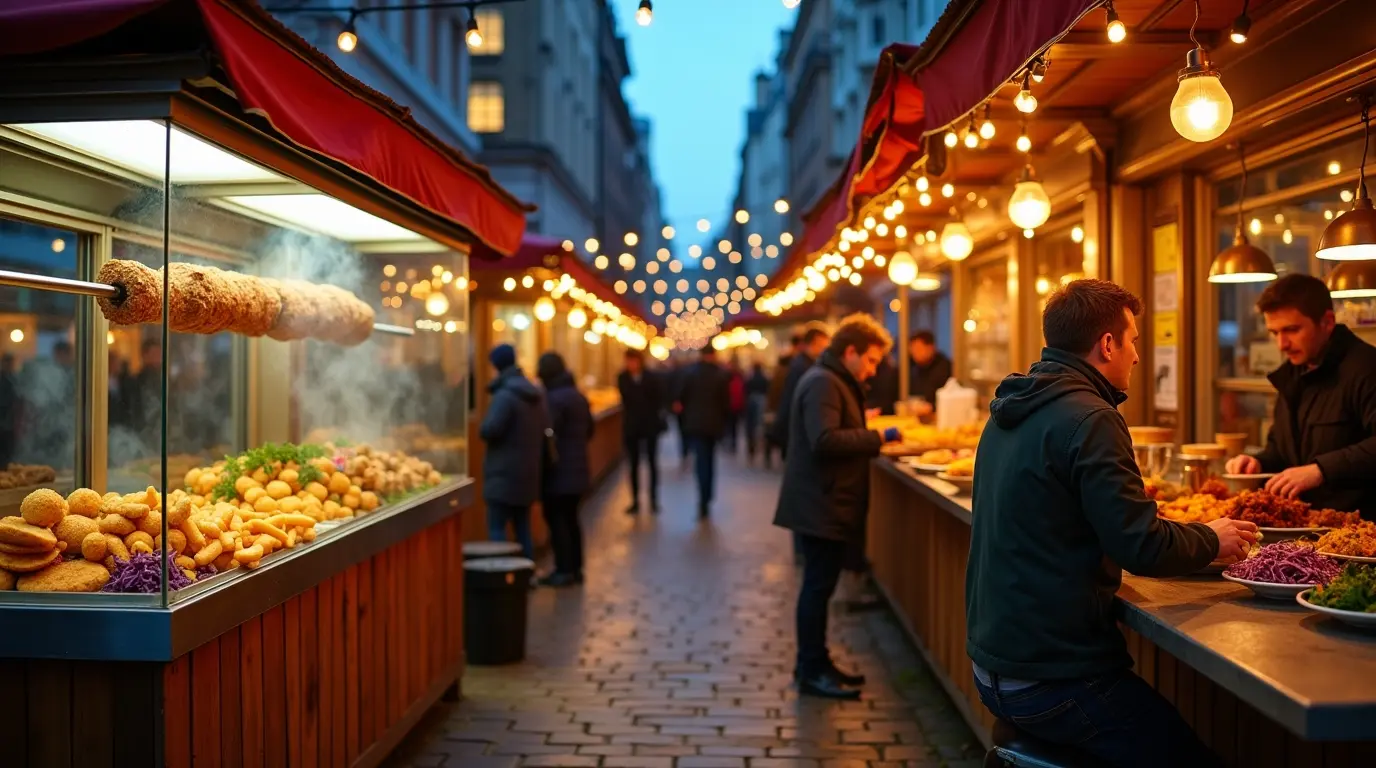Haunted places UK fans, get ready — because this list might just keep you up tonight.
If you’re anything like me, you’ve probably wondered where to find the most haunted places in the UK that still send real shivers down your spine. From eerie forests and ghost-filled castles to strange museums with cursed artefacts, the country is packed with mysterious spots that hide centuries of whispers, sightings, and spine-tingling legends.
Whether you’re planning your next ghost-hunting weekend or just love reading about the UK’s creepiest corners, this guide has you covered. We’ll wander through dark woods, haunted prisons, cursed hilltops, and even a few places where the lights never seem to stay on for long.
From the twisted oaks of Wistman’s Wood in Dartmoor to Pluckley, known as England’s most haunted village, these sites reveal the ghostly side of Britain most people never see.
If you’re brave enough, let’s explore 13 of the most haunted places in the UK — where restless souls, eerie echoes, and centuries-old mysteries still linger in the shadows.
Wistman’s Wood, Dartmoor – The Devil’s Playground of the Moors
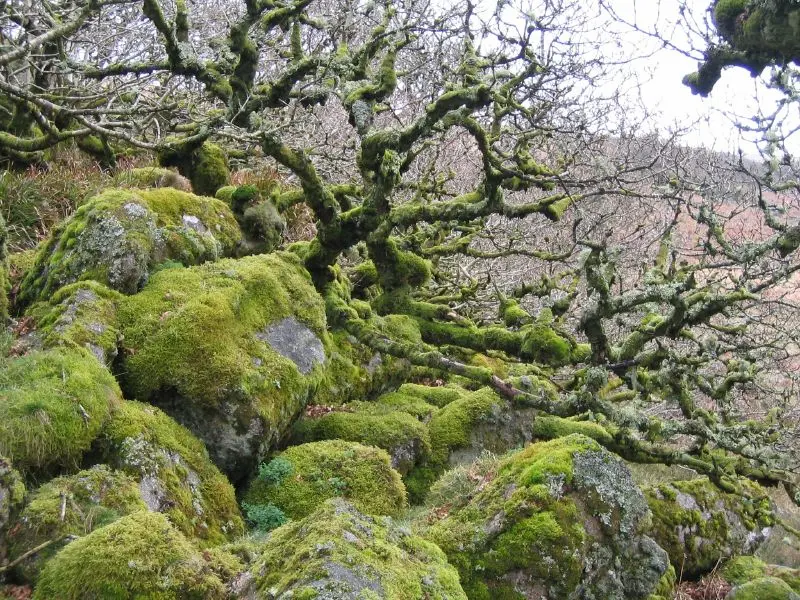
Image Source: Wikipedia, the free encyclopedia
Hidden deep in the wild heart of Dartmoor National Park lies Wistman’s Wood, a forest so ancient and otherworldly it feels alive. The moss-covered branches twist like claws, and the boulders underfoot glisten with dew — it’s no wonder many call it one of the most haunted places in England.
The Haunting Origins of Wistman’s Wood
This mystical woodland dates back thousands of years, a rare survivor of Britain’s original temperate rainforest. The word Wistman likely comes from “Wisht-man,” meaning ghostly or uncanny in old Devon dialect.
Local legend says this forest was once the meeting place for ancient Druids performing secret rituals under moonlight. Later, people believed it became home to the terrifying Wisht Hounds — glowing-eyed black dogs said to hunt across the moors with the Devil himself. They say if you hear their howls, you should never look back.
Ghostly Encounters and Paranormal Signs
Visitors often report spine-chilling experiences here:
- Sudden cold spots and heavy silence, even on warm days
- Muffled footsteps following close behind
- Flickering torches and drained camera batteries
- Quick glimpses of dark shapes darting between trees
Some ghost hunters even claim to have seen the Wisht Hounds stalking through the mist. Others describe an invisible weight pressing down on them — as though the forest itself is watching.
How to Visit Wistman’s Wood (If You Dare)
You can reach the wood via a short 1.5-mile walk from the hamlet of Two Bridges. There’s paid parking across from the Two Bridges Hotel (around £5 for four hours, refundable if you grab a drink or bite inside).
The path runs beside the West Dart River before climbing gently to the woodland edge. I’d recommend visiting early morning for the calm — or at dusk if you’re feeling bold enough to test the legends.
Please note: don’t enter the wood itself. Natural England now asks visitors to walk around its edge to protect rare mosses and lichens that give the forest its haunting green glow. Trust me, the view from outside is magical enough.
If you enjoy exploring eerie landscapes, you might also like my guide to 17 Weird & Quirky Things to Do in London — a few of those places give off similar mysterious vibes.
Baynard House, London – The Brutalist Ghost in the City
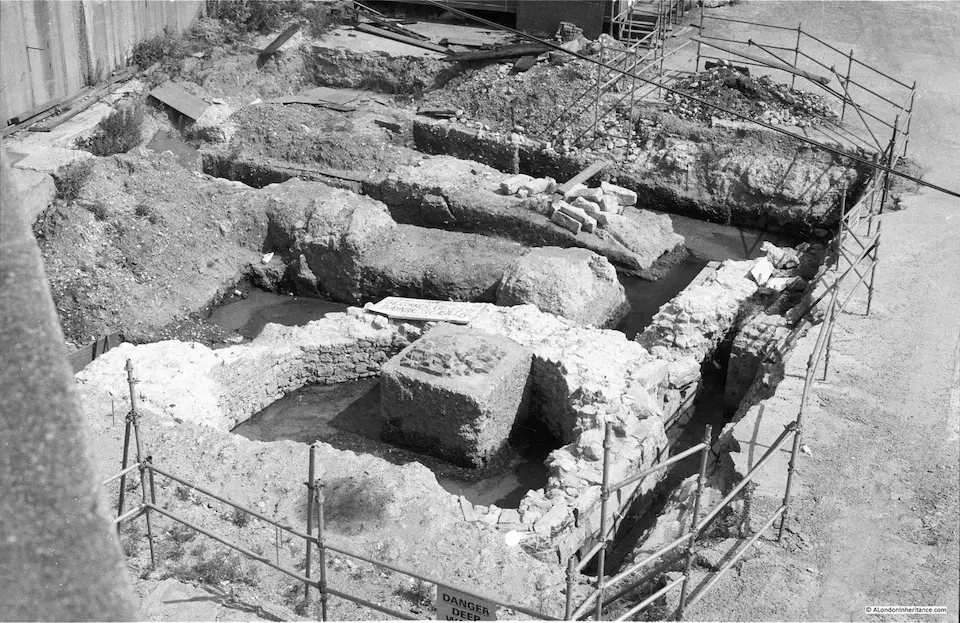
Image Source: A London Inheritance
In the middle of London’s busy streets, Baynard House looms like a concrete ghost. This brutalist office block near Blackfriars might not be centuries old, but it hides one of the most unnerving modern hauntings in the capital.
A Modern Haunting with a Technological Twist
Completed in 1979, Baynard House once served as a Post Office Telecommunications hub and later the BT Museum. Beneath all that concrete ran the UK’s first System X telephone exchange — the beating heart of the nation’s early digital networks.
Maybe it’s that mix of energy and communication that left something lingering. After all, ghosts love places full of connections.
Pop-culture fans might recognise Baynard House from the Channel 4 vampire series Ultraviolet, where it appeared as a secret anti-vampire base. Fitting, isn’t it?
Paranormal Energy Around “The Seven Ages of Man”
The eeriest spot here is the towering totem sculpture called The Seven Ages of Man, unveiled in 1980. Locals swear the stacked faces seem to follow you as you walk by.
Visitors describe:
- Feeling watched or dizzy when near the statue
- Sudden phone battery drains (despite full charge)
- A heavy, silent atmosphere that feels out of place in central London
Even sceptics admit something about the building’s stillness feels wrong — as if time itself has paused.
Visiting Baynard House (Safely)
While the offices aren’t open to the public, you can view the structure and statue from Queen Victoria Street near Blackfriars Station. It’s a fascinating stop for anyone intrigued by haunted places in the UK that blur the line between modernity and mystery.
Interestingly, the surrounding area has its own weird energy — right across the street sits London’s Church of Scientology HQ, and just nearby is where actor Tom Cruise famously broke his ankle filming Mission: Impossible – Fallout. Coincidence? Maybe. But I’m not betting on it.
For fans of strange architecture and offbeat London secrets, it’s a must-see — even if it’s just a quick detour from exploring the best shopping in London.
Chanctonbury Ring, West Sussex – The Devil’s Soup and Screaming Winds
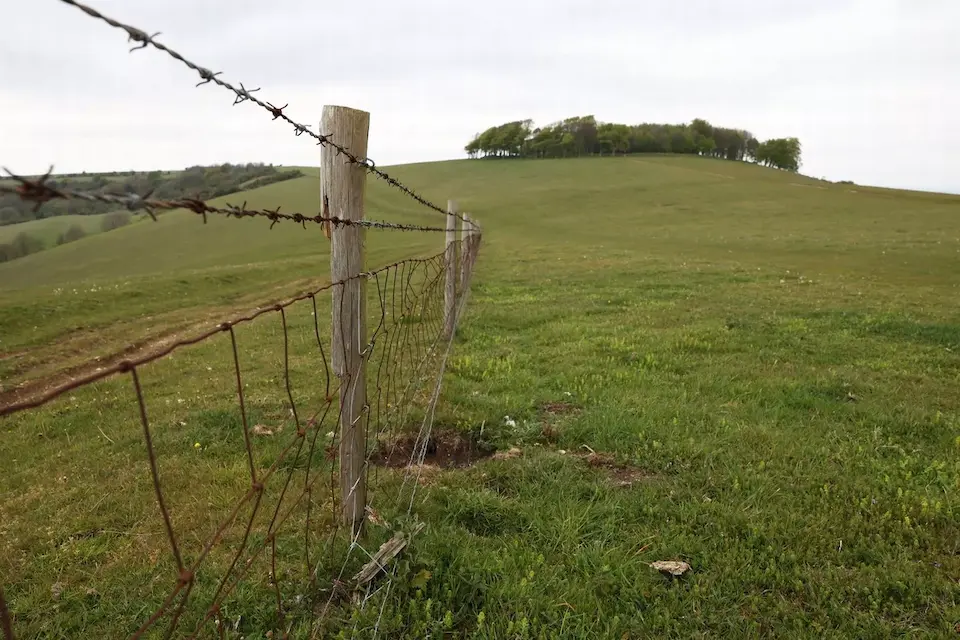
Image Source: Sussex
High on the South Downs sits Chanctonbury Ring, a windswept hill crowned with a perfect circle of beech trees. Some call it beautiful; others call it cursed.
Ancient Legends Beneath the Trees
Long before ghost hunters arrived, this hilltop held Bronze Age burials and an Iron Age fort. Romans later built a temple here, perhaps sensing the place’s strange energy. But the famous tree ring came later — planted in 1760 by Charles Goring, a young aristocrat with a taste for landscape design.
Ever since, strange things have stirred beneath those roots. Locals whisper that walking anti-clockwise around the circle seven times summons the Devil himself — who appears offering a bowl of soup or milk for your soul. Spooky hospitality, indeed.
Chilling Encounters and Mysterious Phenomena
The stories don’t stop there. In 1974, a group of paranormal investigators claimed one member was suddenly lifted into the air and dropped by an invisible force. Others have seen glowing figures, ghostly horses, and a white-bearded druid wandering through the mist.
Even author Robert Macfarlane, who once camped here overnight, described waking at 2 a.m. to blood-curdling screams echoing through the darkness.
How to Visit Chanctonbury Ring
You’ll find the hill just off the South Downs Way near Washington and Findon. There are car parks off both the A283 and A24. The circular Chanctonbury-Cissbury walk (around eight miles) rewards you with incredible coastal views — and maybe a ghost sighting or two.
Many original trees were lost in the 1987 Great Storm, but archaeologists uncovered fascinating ruins beneath the soil during replanting. Despite the fresh growth, the ancient energy remains. Bring a torch, a friend, and a healthy respect for folklore.
If you like mixing the paranormal with the outdoors, you might also enjoy 15 Best Peak District Walks — they’re stunning by day… and who knows what you might feel after dark.
Pitt Rivers Museum, Oxford – Ghosts of Empire and the Unseen
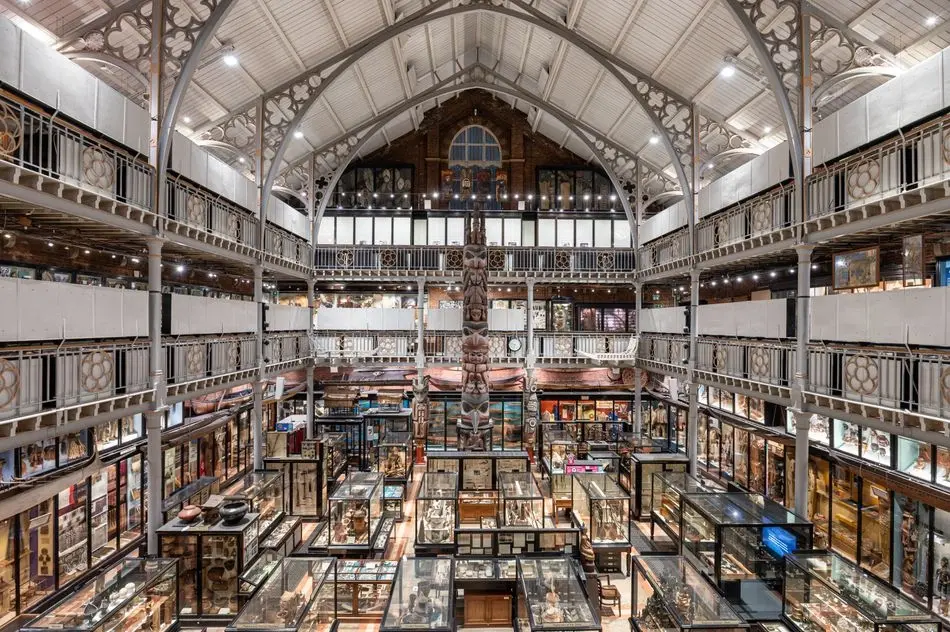
Image Source: Prospect Magazine
Inside Oxford’s university walls, the Pitt Rivers Museum is famous for its dim lighting, glass cases, and eerie calm — a perfect storm for a haunting.
Spiritualism and the Victorian Obsession
Founded in 1884 by General Augustus Pitt-Rivers, the museum began at the height of Britain’s fascination with séances and the supernatural. Even the founder’s family reportedly practised “automatic writing,” letting spirits guide their hands.
It’s easy to feel something otherworldly here. The dark cabinets and narrow aisles seem to hum with quiet energy, as if the exhibits remember more than they reveal.
Strange Energy and Haunted Objects
Many visitors speak of odd sensations:
- Sudden chills or heavy air near certain displays
- Cameras glitching or batteries draining mid-photo
- The feeling of unseen eyes following you between aisles
The museum once displayed shrunken heads from Ecuador — believed to hold the spirits of their former owners — but they were removed in 2020 as part of a major ethical review. Still, many believe those energies linger.
Exploring Pitt Rivers Today
Admission is free, and you’ll find it tucked behind the Oxford University Museum of Natural History. Bring curiosity — and maybe courage.
Wandering through the dim light feels almost spiritual. For me, it’s one of the few haunted places in the UK where history, guilt, and mystery intertwine. You don’t just look at objects here — they seem to look back.
If you love stories that blur culture and the uncanny, you might also enjoy 15 Unusual Free Things to Do in London for more quirky adventures.
Whiteford Lighthouse, Gower Peninsula – The Ghost Light of the Tides
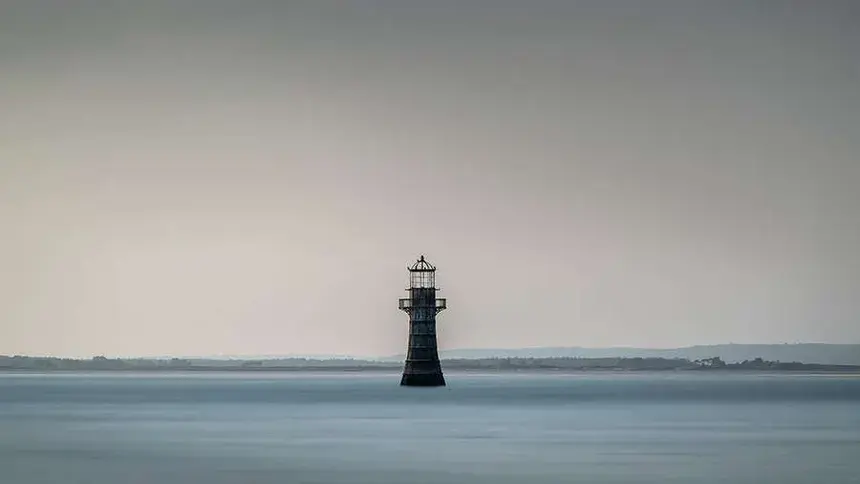
Image Source: Gary Gough
Standing alone against the wild Gower coast, Whiteford Lighthouse feels like something straight from a gothic novel. Rising 44 feet from the shifting sands of the Loughor Estuary, it’s the UK’s only surviving cast-iron lighthouse still battered by the sea — and one of the most hauntingly beautiful haunted places in the UK.
History of a Lonely Beacon
Built in 1865 to replace an older wooden tower, the lighthouse guided sailors past treacherous sandbanks for nearly 70 years. Its name, “Whiteford,” comes from the old Danish words Hvit-Fford, hinting at centuries of seafaring in these turbulent waters.
After decades of faithful service, the light went dark in 1933 — only to flicker briefly back to life in the 1980s when local yachtsmen restored it. But soon after, a failed solar unit silenced it forever, leaving behind an eerie, empty shell.
Phantom Gallops and Whispering Waves
Whiteford Sands is famous not just for its wild tides, but also for the “phantom galloping” that echoes across the shore. Locals describe the sound as thunderous — like a herd of unseen horses charging along the beach before stopping dead at the lighthouse.
Some say it’s the ghost of a woolly mammoth, trapped in time. Others believe it’s the echo of Celtic warriors racing to battle. A few even report misty figures appearing near the lighthouse at dusk. Whatever the cause, the sound is unmistakable — and utterly chilling.
Visiting Whiteford Lighthouse (If You Dare)
Reaching this haunted landmark isn’t for the faint-hearted. The lighthouse sits half a mile offshore and is only accessible at low tide, roughly 90 minutes on either side.
Here’s what to know before you go:
- Parking: Available in a farmer’s field between Cwm Ivy and Llanmadoc (postcode SA3 1DE), with an honesty box system.
- Tide times: Check carefully — the estuary floods fast, and the path disappears completely at high tide.
- Footwear: Wear sturdy shoes; the slippery rocks and shifting sands make every step feel like a ghostly trial.
Walking across the vast wet sands with the tide creeping in behind you? That’s an experience that’ll stay with you long after you’ve gone home.
If you’re into eerie coastal spots, you might also love 17 Best Beaches in the UK — some of those quiet shores hide ghostly tales too.
Glasgow Necropolis – Scotland’s City of the Dead
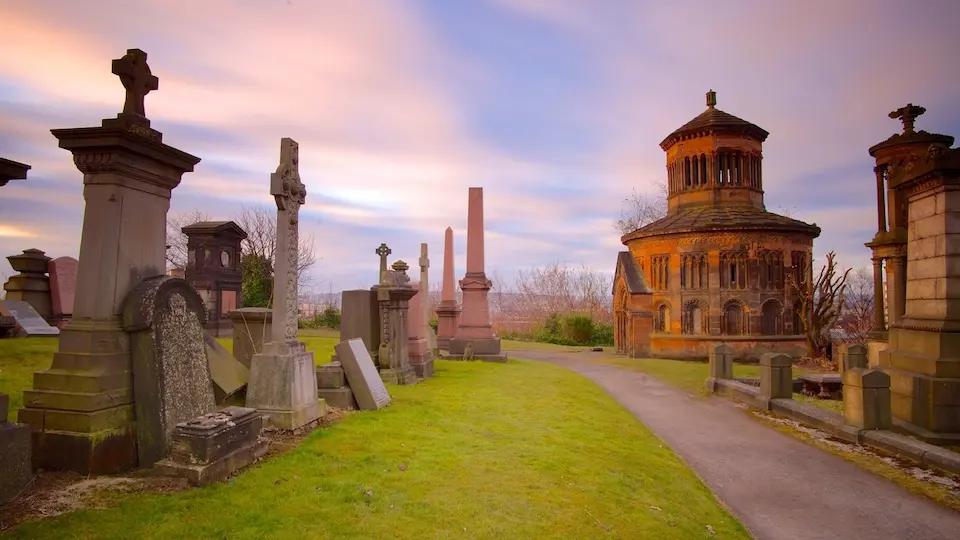
Image Source: Expedia
Perched high above Glasgow’s skyline, the Necropolis is a 19th-century maze of crumbling tombs and whispering angels. More than 50,000 souls rest here — but according to locals, not all of them lie quietly.
A Monumental History
Originally farmland known as Fir Park, the site became Scotland’s first garden cemetery in 1832. The design came from a public competition, and the first burial — in the Jewish section — took place that same year.
As Glasgow grew into an industrial powerhouse, the Necropolis became a grand memorial to the city’s elite. Yet with so many ornate monuments and silent mausoleums, it’s no surprise that it’s now known as one of the most haunted places in the UK.
Eerie Legends and the Gorbals Vampire
Over the years, visitors have reported:
- A white lady gliding between headstones after dark.
- Disembodied whispers from sealed crypts.
- Shifting mists that appear out of nowhere.
- Ghostly children playing among the graves.
Some even claim statues here subtly change expression when no one’s watching.
Although the famous Gorbals Vampire legend actually began in another cemetery, the story adds to Glasgow’s eerie reputation. In 1954, hundreds of schoolchildren armed with sticks stormed a graveyard looking for a seven-foot vampire with iron teeth. The panic grew so large it led to a new law banning horror comics in Britain — proving how deeply the city’s ghost stories run.
How to Visit Glasgow Necropolis
Today, the Necropolis welcomes visitors year-round as both a park and historic site. The Friends of Glasgow Necropolis run free guided tours, sharing stories of the people buried here — and the mysteries that linger.
You don’t have to believe in ghosts to feel the atmosphere. Standing at the top of the hill, surrounded by angels and mist, the city of the living feels far, far away.
If you enjoy eerie urban sites, you might also fancy exploring 13 Most Dangerous Areas in London — spooky in a more modern sense!
Samson Island, Isles of Scilly – The Cursed Island that Time Forgot
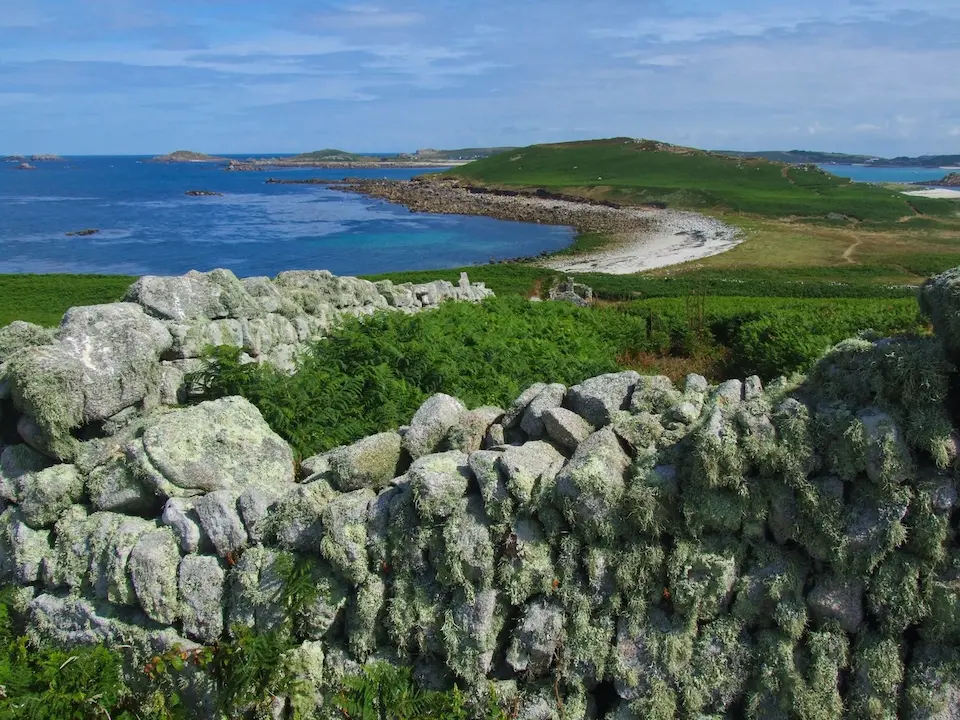
Image Source: Martin Hesp
In the far southwest, among the scattered Isles of Scilly, lies Samson Island — a place so eerily quiet that even animals refuse to stay. Uninhabited since the 1850s, this lonely patch of land is steeped in tragedy and ghostly legend.
The Forgotten Families of Samson
Once home to the Woodcock and Webber families — believed to be descendants of shipwrecked sailors — Samson’s story is one of isolation and hardship. By 1855, when Augustus Smith, the island’s landlord, discovered the remaining inhabitants starving and ill, he forced them to leave. They never returned.
Echoes of Desperation
Visitors still report the sense of being watched among the ruined cottages. Some hear footsteps in the sand or soft voices carried by the wind. According to local tales, a curse was placed upon the island as its last residents were taken away. Even deer introduced later tried to swim off — many drowning in the attempt.
If there’s anywhere that embodies pure melancholy, it’s here.
Visiting Samson Island Today
You can reach Samson by boat from other Scilly islands, but be aware — there’s no quay, and you’ll disembark directly onto the beach. Trips depend on weather and tides, and some parts close during seabird nesting season (March–August).
Bring water, a picnic, and a good pair of boots. Once you step onto its shores, you’ll understand why Samson is one of the most haunted places in the UK — silent, empty, and hauntingly beautiful.
If desolate adventure is your thing, check out 17 Easy Day Trips from London — some have wild, remote energy that rivals this ghostly isle.
Boggart Hole Clough, Manchester – The Forest of Mischievous Spirits
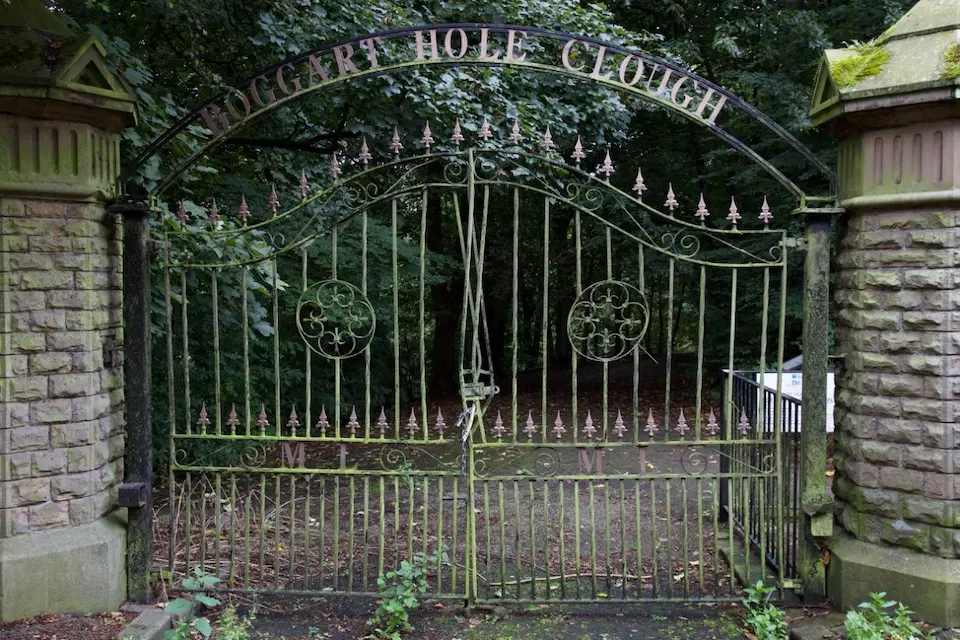
Image Source: Manchester’s Finest
Just a few miles from Manchester city centre hides Boggart Hole Clough, a tangle of ancient woodland where mischief, folklore, and fear intertwine. Even its name hints at trouble — a boggart is a shapeshifting household spirit from Lancashire legend.
Where Folklore Meets Fear
For centuries, locals have told tales of a farm so haunted by a boggart that its family fled in terror. But as they moved, they heard a mocking voice whisper, “Aye, we’re flitting,” — meaning the spirit had followed them. The message? You can’t escape what haunts you.
Supernatural Signs in the Woods
Visitors to the park today still report unnerving experiences:
- Milk souring overnight.
- Objects vanishing and reappearing in odd places.
- Dogs refusing to enter certain paths.
- A feeling of eyes watching from behind the trees.
Some even link the boggart’s presence to mysterious child disappearances from centuries past — though no one can prove it.
Exploring Boggart Hole Clough Today
Now a public park open daily, the Clough offers hiking trails through deep ravines and shadowy woods. It’s an ideal place for a daytime stroll — or a daring twilight walk if you’re chasing chills.
Interestingly, J.K. Rowling borrowed the word boggart for her Harry Potter books, where the creature becomes what you fear most. After visiting this place, you’ll see why.
If you love eerie woodland escapes, take a look at 17 Best Parks in London — they’re far friendlier, I promise!
The Forbidden Corner, North Yorkshire – The Maze of Madness
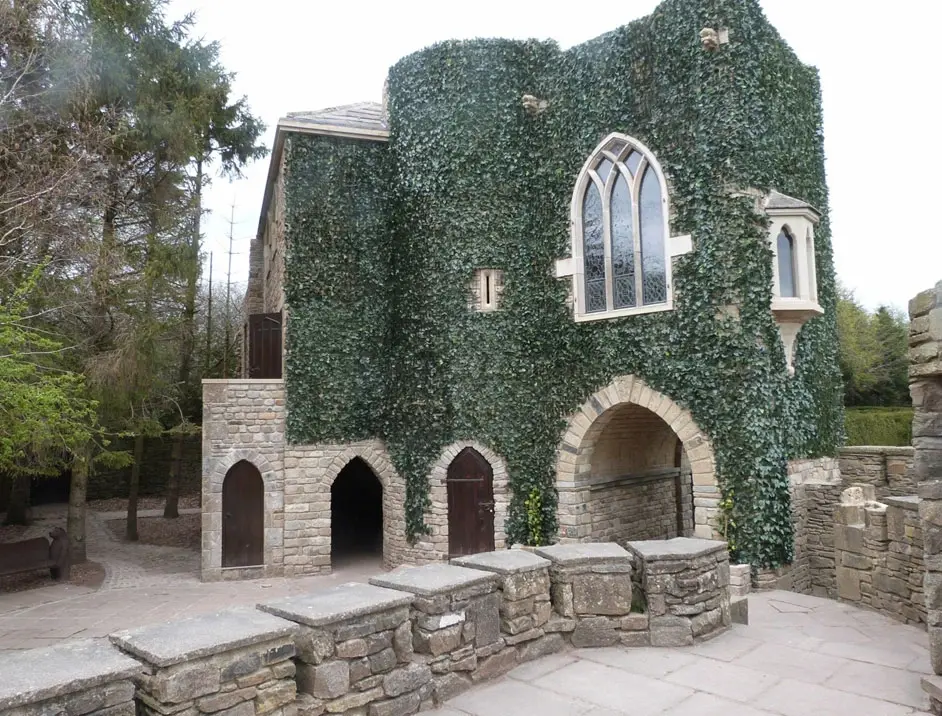
Image Source: The Forbidden Corner
Welcome to The Forbidden Corner, a place designed to confuse, delight, and terrify in equal measure. Hidden in the Yorkshire Dales, this surreal attraction mixes optical illusions, creepy tunnels, and eerie sculptures that make it one of the strangest haunted places in England.
From Private Folly to Public Mystery
Originally built in 1989 as a private folly by Colin Armstrong, this labyrinth of tunnels, towers, and tricks became so popular it opened to the public in 2000 after a massive petition. Since then, it’s been described as “the strangest place in the world” — and for good reason.
Tricks, Terrors, and Unexpected Hauntings
The Forbidden Corner might not have real ghosts, but it’s full of bizarre surprises:
- The Armstrong Mausoleum, with its chilling echo chamber.
- Talking statues and secret doors.
- Rotating floors and sudden darkness.
- An underground temple that feels far too real.
Every Halloween, the place transforms — actors dressed as skeletons, witches, and monsters roam freely, adding a touch of genuine fear to the fun.
Plan Your Visit
Tickets must be booked in advance (around £18 for adults, £16 for kids, or £62.50 for a family). Once inside, you’ll weave through hidden passages, encounter singing mice, and possibly question your sanity.
Afterwards, grab a slice of pie at the Corner Café — you’ve earned it.
If quirky attractions are your thing, check out 18 Secret Thrift Shops London — they’re a maze of treasures too, just with fewer ghosts!
Pluckley Village, Kent – Britain’s Most Haunted Village
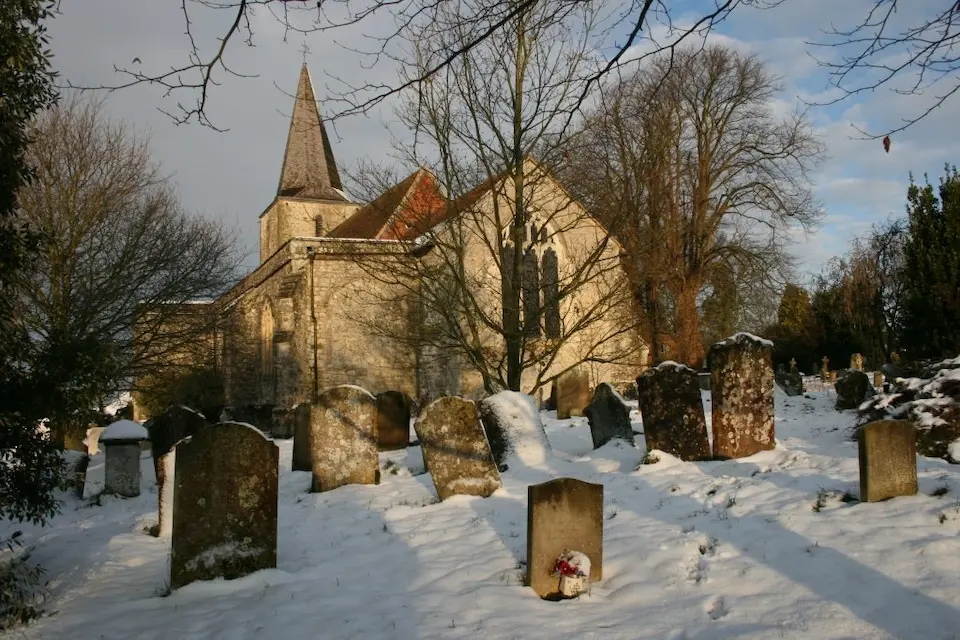
Image Source: Pluckley
Recognised by the Guinness Book of Records back in 1989 as “the most haunted village in Britain,” Pluckley still holds its ghostly crown. This quiet Kentish village may look picture-perfect, but behind the pretty cottages and old pubs hide a dozen or more restless spirits.
Tragic Tales and Twisting Folklore
Though Pluckley’s roots stretch back to Roman times, most of its ghost stories surfaced much later. Research by Dr. Simon Moreton from the University of West England revealed that many tales were actually shaped in the 1950s by local storyteller Frederick Sanders.
Still, some of these stories link to real tragedies — like Sarah Sharp, the “Watercress Woman,” who burned to death in 1911, and Mary Ann Bennett, the “Lady of Rose Court,” who took her own life in 1862. It’s a chilling reminder that every haunting begins with a human story.
Meet Pluckley’s Ghostly Residents
It’s said there are at least twelve ghosts in Pluckley, including:
- The Screaming Man, a brickworker who fell to his death.
- A Highwayman stabbed to a tree at Fright Corner.
- The Schoolmaster who hanged himself and still wanders in his old coat.
- The Red Lady and White Lady who haunt St Nicholas Church.
- A Colonel seen swinging from a branch in Park Wood.
And just outside the village lies Dering Woods, nicknamed “The Screaming Woods” — where eerie cries pierce the night air. Even the Black Horse Pub has its own stories of moving glasses and dogs that refuse to enter certain rooms.
How to Visit Pluckley Village
You can join guided ghost walks through the official Pluckley Ghost Walk, which supports local businesses. Visitors are asked to follow the Pluckley Pledge — “No Litter, No Noise, No Damage, No Nuisance.”
The Blacksmith’s Arms, once called The Specter’s Arms, has now closed, but The Black Horse Inn remains the perfect stop for a pint and a good scare.
If eerie villages fascinate you, check out 13 Best Places to Live in London — not all of them are haunted… hopefully.
Pendle Hill, Lancashire – The Cursed Land of the Witches
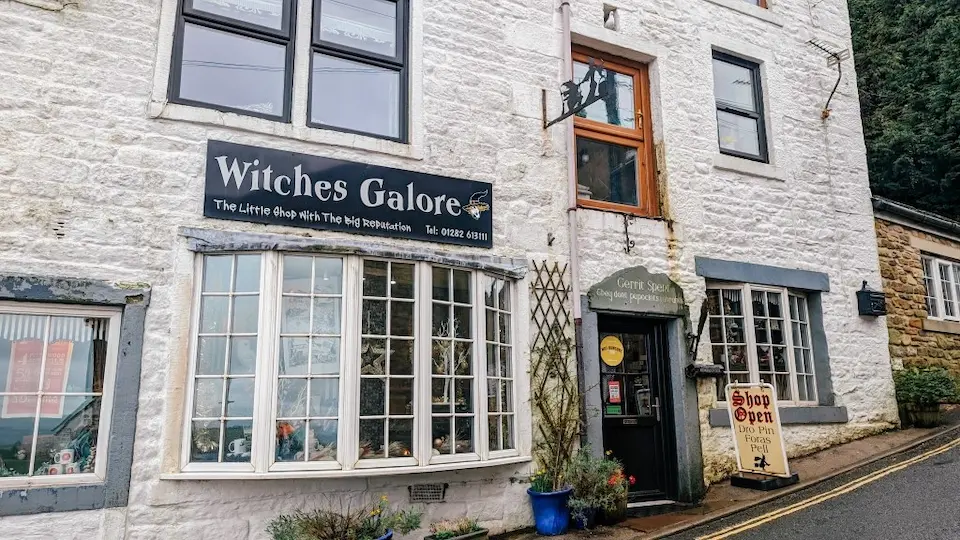
Image Source: The Morbid Tourist
Rising above Lancashire’s moors, Pendle Hill has a dark reputation tied to one of the most infamous witch trials in English history. Even today, this rugged landscape feels heavy with secrets — and sorrow.
The Real Story Behind the Pendle Witches
In 1612, twelve locals were accused of witchcraft after ten mysterious deaths. Most were poor women — healers or widows — from two rival families led by Elizabeth Southerns (Old Demdike) and Anne Whittle (Mother Chattox).
Their trial at Lancaster Castle was a spectacle. A nine-year-old girl, Jennet Device, even testified against her own family. Ten were executed by hanging; only one survived.
Since then, Pendle Hill has become one of the most notorious haunted places in the UK, with locals claiming the spirits of the accused still wander its slopes.
Ghostly Encounters on Pendle Hill
Those who dare to explore after dark report:
- A crushing sense of anger or grief in certain spots.
- Cold gusts and sudden whispers on still nights.
- Unseen hands grabbing at clothes or throats.
Even the crew from Most Haunted reported being scratched and choked during filming here. Few places feel this raw — as though centuries of fear still echo in the soil.
Visiting Pendle Hill Today
The steep climb from Barley village is the most popular route, with parking nearby. For full context, visit Lancaster Castle and Gallows Hill in Williamson Park — both linked to the witch trials.
If you’re planning a Halloween visit, prepare carefully: charge your phone, dress warmly, and bring a torch. The hill’s weather changes fast — and so, some say, do its moods.
If legends of witchcraft intrigue you, you might also love 18 Mind-Blowing Immersive Experiences in London — modern-day magic of a very different kind.
Chillingham Castle, Northumberland – The Classic English Haunting
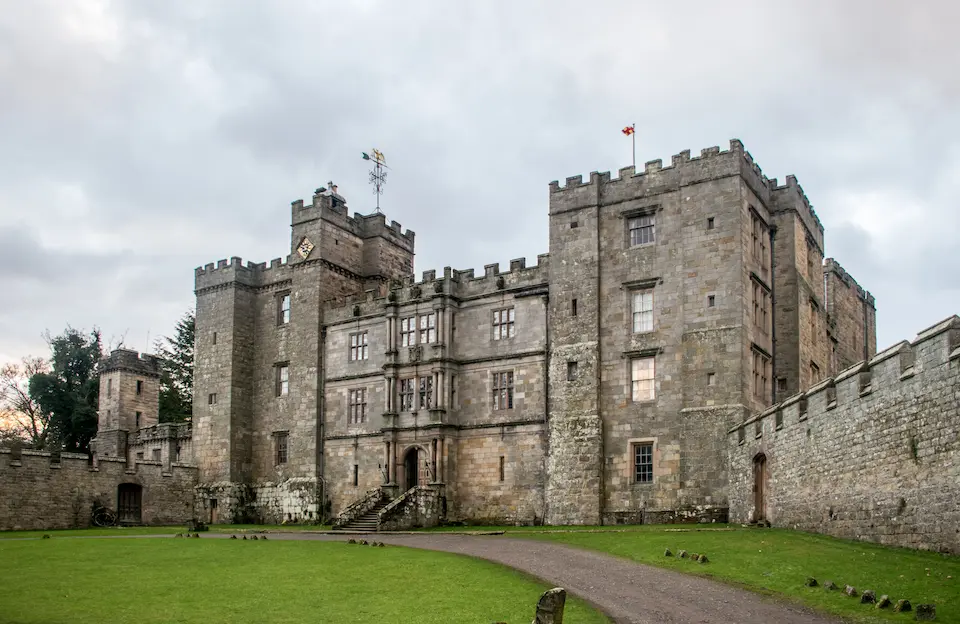
Image Source: en.wikipedia.org
If there’s one castle that defines ghostly Britain, it’s Chillingham Castle. With centuries of war, torture, and tragedy behind its walls, this 13th-century fortress is widely believed to be the most haunted castle in England.
A Fortress Steeped in Blood
Built in the 1200s, Chillingham guarded England’s border during brutal conflicts with Scotland. King Edward I stayed here in 1298 before marching north against William Wallace. Over the years, the castle witnessed endless battles, sieges, and deaths — leaving behind a psychic scar that never healed.
Spirits of Chillingham Castle
Guests and staff have reported countless apparitions, including:
- The Blue Boy, whose cries once echoed through the Pink Room. His skeleton was found sealed behind a wall, wrapped in blue cloth.
- The Lady in White, forever searching for water after being poisoned.
- Ghostly voices in the chapel, murmuring mid-conversation before falling silent.
No wonder reviewers consistently call this one of the scariest haunted places in the UK.
How to Visit Chillingham Castle
The castle is open from April to early November (11am–5pm). Adult tickets cost around £14, while evening ghost tours run about £25.
If you’re feeling especially brave, book one of the overnight ghost hunts for roughly £50 — just don’t expect to sleep much. Bring a torch, wrap up warm, and keep your courage handy.
You can even stay overnight in self-catering apartments within the castle grounds. Just maybe… leave the lights on.
If eerie heritage sites fascinate you, you’ll enjoy exploring 15 Must-Visit Free Museums in London, where history whispers in quieter tones.
Rendlesham Forest, Suffolk – Britain’s Roswell
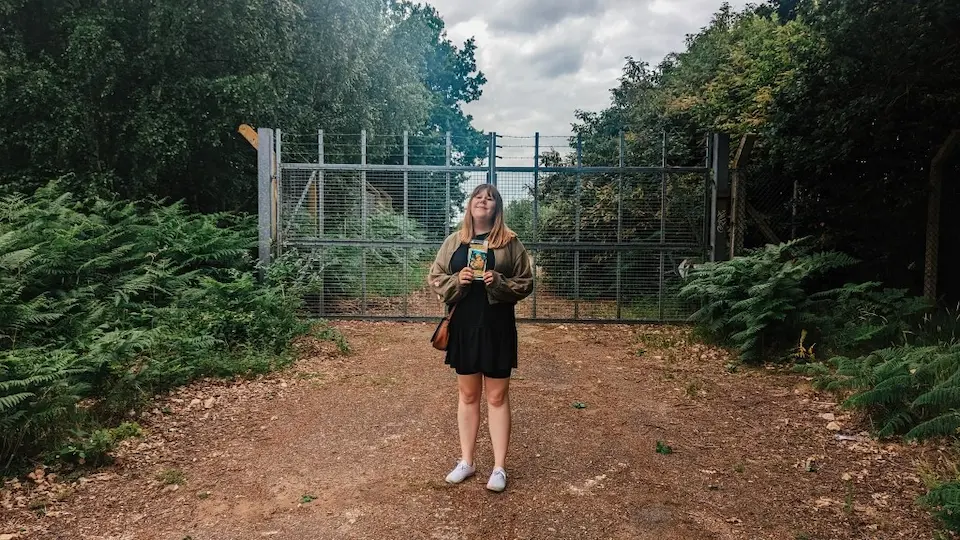
Image Source: The Morbid Tourist
Not all hauntings involve ghosts. In Rendlesham Forest, the strange lights come from the sky. This quiet corner of Suffolk is home to the UK’s most famous UFO encounter — a story that’s baffled believers and sceptics alike since 1980.
The Night the Lights Landed
In December 1980, U.S. Air Force officers stationed at nearby RAF Woodbridge spotted glowing lights descending into the trees. When they investigated, they found scorched ground, high radiation levels, and a metallic object that vanished before their eyes.
Two nights later, the deputy base commander, Lt. Col. Charles Halt, led a second team — and recorded the entire event. His official memo later confirmed “unexplained lights” and radiation levels above normal background readings.
Lingering Mysteries in the Forest
Today, visitors still see flashes of light, orbs floating between the trees, and sudden drops in temperature. Whether it was alien craft, military testing, or just imagination — the sense of mystery lingers.
Walking the UFO Trail
The forest has embraced its legend with an official UFO Trail, a three-mile circular walk from the main car park (Rendlesham Forest, Tangham, Woodbridge, IP12 3NF). It takes about 90 minutes and passes information boards marking key spots from the 1980 incident.
Even sceptics admit that once you’re deep among the pines, things start to feel… strange.
If you’re fascinated by unexplained mysteries, you’ll also enjoy reading about The Secret Formula Behind Tourist Attractiveness — because some places just feel magnetic, don’t they?
Comparing the Spookiest Spots: Haunted Places in the UK at a Glance
To help you pick your next spooky adventure, here’s a quick comparison of all the terrifying haunted places in the UK I’ve covered!
| Location | Type of Haunting | Key Era | Access Level | Key Visitor Tip |
| Wistman’s Wood | Folklore & Natural Atmosphere | Ancient / Primeval | Moderate (uneven walk) | Don’t walk in the wood; stay on paths to protect ecosystem. |
| Baynard House | Modern / Psychological | 20th Century | Exterior view only | It’s a private office; view the statue from public walkway. |
| Chanctonbury Ring | Layered Historical / Demonic | Multi-Era (Bronze Age-Roman) | Moderate (steep inclines) | Wear sturdy boots; multiple car parks available. |
| Pitt Rivers Museum | Ethical / Post-Colonial | Victorian / Colonial | Easy (Free Entry) | Human remains no longer displayed. Consider ethical context. |
| Whiteford Lighthouse | Auditory Phenomenon | 19th Century | Difficult (Tide-Dependent) | Vital: Check tides! ~90 min low tide access window only. |
| Glasgow Necropolis | Victorian Gothic / Urban Legend | 19th Century | Easy (Guided Tours) | “Gorbals Vampire” was at Southern Necropolis, not here. |
| Samson Island | Desolation & Cursed Atmosphere | 19th Century | Difficult (Boat & Beach Landing) | Boat trips seasonal; no facilities on island. |
| Boggart Hole Clough | Folkloric Creature | Ancient / Bronze Age | Easy (Public Park) | Family park with unsettling local folklore. |
| The Forbidden Corner | Manufactured / Folly | 20th Century | Easy (Pre-booking essential) | Intentionally strange, not a traditional haunting. |
| Pluckley Village | Community Folklore | 20th Century (origins) | Easy (Public Access) | Respect “Pluckley Pledge” & residents. |
| Pendle Hill | Historical Trauma / Witchcraft | 17th Century | Moderate (steep climb) | Path from Barley is popular; check routes. |
| Chillingham Castle | Classic Castle Haunting | 13th Century | Easy (Paid Entry / Tours) | Book ghost tours/hunts well in advance. |
| Rendlesham Forest | Extraterrestrial / UFO | 20th Century | Easy (Marked Trail) | Follow the 3-mile UFO Trail for a unique experience. |
Conclusion – The Spirits, the Stories, and the Spine-Chills
From the eerie moors of Dartmoor to the silent sands of Samson Island, these 13 haunted places in the UK prove one thing — our island’s ghosts are as varied as its landscapes.
Some hauntings speak of tragedy, others of mystery, and a few simply remind us how deeply the past lingers in Britain’s bones. Whether it’s the tortured souls of Pendle Hill, the cries from Chillingham Castle, or the whispers in Pluckley Village, every site tells a story worth hearing.
If you plan to visit, remember the Pluckley Pledge — No Litter, No Noise, No Damage, No Nuisance. Respect the living, the dead, and the land that holds them both.
Personally? I’d start small — a daytime stroll through Wistman’s Wood, perhaps. Work your way up to an overnight ghost hunt when you’re ready. And don’t forget extra batteries… they tend to drain faster in places like these.
If you need a break from the chills, explore something lighter next — maybe 17 Best Vegan Restaurants in London or 15 Best Fish and Chips in London — comfort food helps after a fright!
FAQs: Your Haunted Places in the UK Questions Answered!
Got a few more questions buzzing around about the haunted places in the UK? No worries, I’ve put together some quick answers for you!
Q1. What is considered the most haunted location in the UK?
A1. Honestly, it’s a tough one, but Chillingham Castle in Northumberland is almost always at the top of the list. It’s famous for having loads of different ghosts, and a huge number of visitors report supernatural experiences.
Q2. Which village in Britain is known for having the most ghosts?
A2. That would be Pluckley Village in Kent! It was officially named Britain’s most haunted village by the Guinness Book of Records. It’s said to have 12-14 different ghosts, including the Red Lady, White Lady, and a highwayman.
Q3. Are there any haunted places in the UK associated with UFO sightings?
A3. Yes! If you’re into X-Files stuff, you have to visit Rendlesham Forest in Suffolk. It’s known as “Britain’s Roswell” because of a massive UFO incident in 1980. You can even walk the 3-mile UFO trail.
Q4. Can you visit haunted locations in the UK for overnight stays?
A4. Some of them, yes! Chillingham Castle, for example, offers overnight ghost hunts. They also have self-catering apartments in the castle grounds if you’re really brave. These events let you do proper paranormal investigations after dark.
Q5. Are there any precautions to take when visiting haunted places in the UK?
A5. Definitely. When visiting haunted locations, it’s important to respect local communities and follow guidelines like the “Pluckley Pledge: No Litter, No Noise, No Damage, No Nuisance”. Also, dress warmly and bring torches for night-time visits, as many old buildings can get very cold. For remote locations like Whiteford Lighthouse, always check tide times before setting out.
